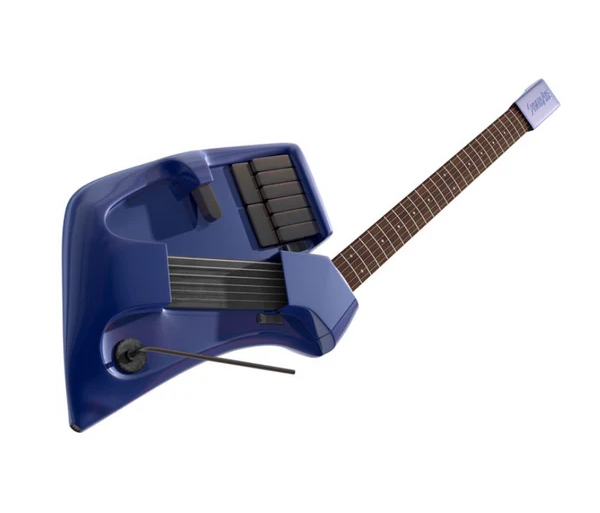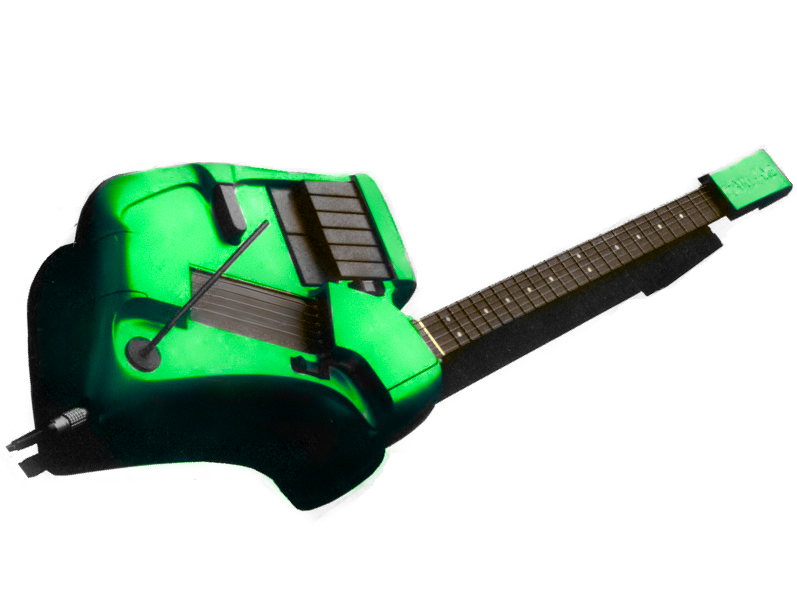SynthAxe
Electronic Instruments
Europe
Between 1901 and present
Video
The SynthAxe is an advanced MIDI (Musical Instrument Digital Interface) controller that redefined the possibilities of electronic music. Unlike traditional stringed instruments, it does not produce sound on its own but instead transmits MIDI signals to external synthesizers, allowing musicians to control a vast range of sounds. With its unique structure and design, the SynthAxe was favored by innovative guitarists and electronic music composers looking for new ways to express their creativity.
Description
The SynthAxe is a hybrid instrument combining characteristics of both a guitar and a synthesizer. Unlike a conventional guitar, it lacks standard pickups and does not rely on the vibration of strings to generate sound. Instead, it functions as a MIDI controller, converting finger and hand movements into digital signals that communicate with synthesizers, samplers, or computer-based music production systems.
Type of Instrument
The instrument is designed to accommodate guitarists who are accustomed to traditional fretting and picking techniques but want to explore electronic soundscapes. It features a neck similar to a guitar’s, with frets that detect finger pressure and movement, and a separate picking interface that allows real-time control over dynamics and articulation. The SynthAxe offers incredible flexibility, enabling players to trigger a wide range of synthesized sounds, from orchestral instruments to futuristic electronic tones.
History and Origin
The SynthAxe was developed in the early 1980s by a British team led by Bill Aitken, Mike Dixon, and Tony Sedivy. The goal was to create a revolutionary instrument that combined the expressiveness of a guitar with the limitless sound possibilities of synthesizers. The instrument was officially released in 1985 by the SynthAxe company and gained recognition for its advanced MIDI capabilities.
One of the most well-known users of the SynthAxe was British fusion guitarist Allan Holdsworth, who used the instrument extensively in his music. Holdsworth’s intricate legato playing style and preference for non-traditional sounds made the SynthAxe an ideal tool for his compositions. Through Holdsworth and other pioneers, the SynthAxe demonstrated its potential in jazz fusion, progressive rock, and electronic music.
Despite its groundbreaking technology, the SynthAxe remained a niche instrument. Its high cost—around £10,000 at the time—limited its accessibility, and the complexity of its design meant it required a steep learning curve. As a result, production ceased in the early 1990s, making it a rare and sought-after collector’s item today.
Types and Features
The SynthAxe, while not available in multiple model variations, incorporated several features that set it apart from other MIDI controllers and guitar synthesizers of its time.
Types of SynthAxe
Although there was no distinct classification of SynthAxe models, variations existed in terms of customized configurations for individual players. Some units featured additional MIDI functionalities, while others were fine-tuned for specific performance needs. However, all SynthAxe units shared the same core design and technological principles.
Features of the SynthAxe
The SynthAxe boasted numerous advanced features that made it one of the most sophisticated MIDI controllers of its era:
MIDI Connectivity – The instrument’s MIDI capabilities allowed it to control external synthesizers, giving musicians access to virtually any sound.
String and Fret Sensors – Instead of traditional strings, the SynthAxe employed touch-sensitive frets and a picking mechanism that detected pressure and movement, ensuring precise control over pitch and expression.
Multiple Playing Interfaces – The instrument included separate systems for fretting and picking, allowing for enhanced articulation and unique performance techniques.
Customizable Controls – Various MIDI parameters could be assigned to different gestures, enabling real-time modulation of sound characteristics.
Ergonomic Design – The SynthAxe’s structure was designed for comfort and ease of use, with a futuristic aesthetic that set it apart from traditional guitars.
These features made the SynthAxe an incredibly versatile tool for experimental musicians, particularly those exploring electronic and fusion genres.
The SynthAxe in Music
The introduction of the SynthAxe provided musicians with an entirely new way to interact with synthesizers, expanding the boundaries of guitar-based music.
One of the most significant aspects of the SynthAxe was its ability to mimic and control a variety of sounds. Unlike traditional guitar synthesizers, which often suffered from latency issues and limited tracking accuracy, the SynthAxe provided a seamless and responsive playing experience. This made it a favored instrument for musicians who wanted to explore complex textures and sonic landscapes beyond what was possible with a standard electric guitar.
Jazz fusion and progressive rock artists were among the primary adopters of the SynthAxe. Allan Holdsworth was its most famous advocate, using it on albums such as Atavachron and Sand. Holdsworth’s fluid legato technique was enhanced by the SynthAxe’s ability to sustain notes indefinitely and create intricate harmonies that would be difficult to achieve on a traditional guitar. Beyond Holdsworth, the SynthAxe found limited use in mainstream music due to its high cost and unconventional interface. However, it remained an influential tool in experimental and electronic music circles, inspiring future developments in MIDI guitar technology.
Significance of the SynthAxe
Despite its rarity and the eventual discontinuation of production, the SynthAxe holds significant importance in the history of musical instruments. It was one of the first MIDI controllers designed specifically for guitarists, paving the way for future innovations in electronic music performance.
The SynthAxe demonstrated the potential of MIDI technology in live performance, showcasing how musicians could move beyond the constraints of acoustic and electric instruments. Its advanced capabilities influenced the development of modern guitar synthesizers, MIDI controllers, and digital instruments that continue to shape the music industry.
Additionally, the SynthAxe serves as a testament to the possibilities of blending traditional musicianship with cutting-edge technology. While it never achieved mainstream popularity, it remains a symbol of musical innovation, inspiring both musicians and instrument designers to push the boundaries of what is possible.
The SynthAxe was a groundbreaking instrument that redefined the possibilities of electronic and guitar-based music. Its unique design, MIDI capabilities, and expressive features made it a powerful tool for musicians seeking to explore new sonic territories. Although its high cost and complexity limited its widespread adoption, the SynthAxe remains a revered and influential instrument in the history of music technology. Today, it stands as a symbol of innovation, reminding musicians and inventors alike of the limitless potential of musical expression through technology.
FAQ
What materials are used to make the SynthAxe?
The SynthAxe is primarily constructed from high-quality metals and composite materials. The neck and body are made of aluminum and fiberglass, ensuring durability and precision. The fretboard incorporates electronic sensors to detect finger placement. These materials contribute to its futuristic design and reliability.
What is the SynthAxe made of?
The SynthAxe is made of a combination of aluminum, fiberglass, and plastic. The body is reinforced for structural stability, while the neck is built for accurate pitch tracking. Its ergonomic design helps musicians play comfortably. The materials enhance its electronic integration.
How is the SynthAxe constructed?
The SynthAxe is built with a metal and composite frame, featuring an independent neck and body design. Electronic sensors in the fretboard track finger position, while MIDI outputs control synthesizers. The unique stringless design allows pitch bending and modulation. Its ergonomic layout aids in expressive performance.
 Links
Links
References
Other Instrument
Categories



















